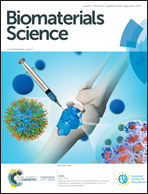Coaxial PCL/PEG-thiol–ene microfiber with tunable physico-chemical properties for regenerative scaffolds†
Abstract
Tissue regeneration requires scaffolds that exhibit mechanical properties similar to the tissues to be replaced while allowing cell infiltration and extracellular matrix production. Ideally, the scaffolds’ porous architecture and physico-chemical properties can be precisely defined to address regenerative needs. We thus developed techniques to produce hybrid fibers coaxially structured with a polycaprolactone core and a 4-arm, polyethylene glycol thiol–norbornene sheath. We assessed the respective effects of crosslink density and sheath polymer size on the scaffold architecture, physical and mechanical properties, as well as cell–scaffold interactions in vitro and in vivo. All scaffolds displayed high elasticity, swelling and strength, mimicking soft tissue properties. Importantly, the thiol–ene hydrogel sheath enabled tunable softness and peptide tethering for cellular activities. With increased photopolymerization, stiffening and reduced swelling of scaffolds were found due to intra- and inter-fiber crosslinking. More polymerized scaffolds also enhanced the cell–scaffold interaction in vitro and induced spontaneous, deep cell infiltration to produce collagen and elastin for tissue regeneration in vivo. The molecular weight of sheath polymer provides an additional mechanism to alter the physical properties and biological activities of scaffolds. Overall, these robust scaffolds with tunable elasticity and regenerative cues offered a versatile and effective platform for tissue regeneration.



 Please wait while we load your content...
Please wait while we load your content...